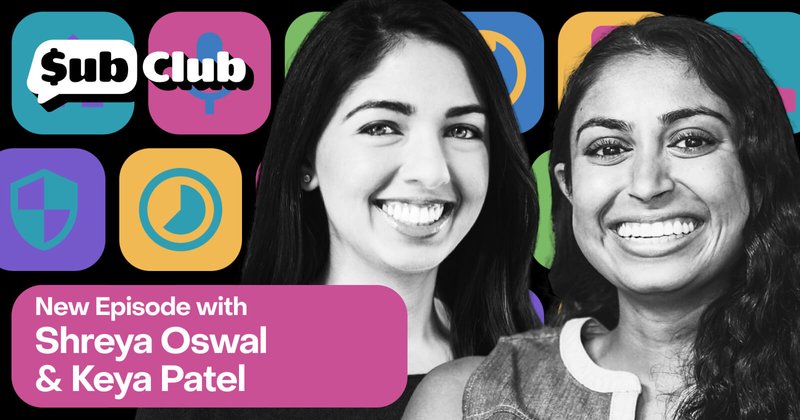How Headspace optimized revenue by gating content — Shreya Oswal and Keya Patel, Headspace
In this episode, Shreya and Keya explore Headspace's freemium model evolution, mission-monetization balance, and the power of incentive-free referral programs.

It might seem crazy to rely on referral marketing — with no incentives — to promote your app’s growth. But that’s exactly what meditation and sleep app Headspace found works best.
In this episode of the Sub Club podcast, Headspace Senior Director of Product Management over membership Shreya Oswal, and former Director of Product Management over growth Keya Patel talk about why intrinsic rewards work better than transactional ones.
Originally, Headspace had a lot of freely available content. This was to fulfill their mission of giving people access to the app’s most loved and popular content, by offering it on platforms like YouTube and a partnership with Netflix. Eventually, the team started experimenting with upsell strategies — and what might convert more free users to paid users at quicker rates.
Testing user behavior in locked content environments
That’s when they started testing user behavior in locked content environments. Would users stay around and stay engaged at the same rates as previously, while still converting at a higher rate?
The answer turned out to be yes: Headspace found users were more likely to convert with more locked content.
Why? Because they were hitting more paywalls and seeing more locked icons — just like in other paid products they were used to, such as Spotify. Because of that familiarity, Headspace didn’t encounter as much of the pushback that they expected they would, and the member experience team weren’t bombarded with complaints. Instead, they saw a high lift in conversion.
The team prioritized experimenting with newer users who didn’t know about the freemium product, and so lacked strong expectations for paid versus free features. For those who did have experience, Headspace was careful to gently transition them. The team also published popular content on YouTube and Netflix for free — with the company mission firmly in mind.
Experimenting with 100% locked content
Then when Shreya joined Headspace in the wake of Keya’s moving on, the company went further: They tried out 100% locked content. Previously, some users would repeatedly access certain free content without encountering upsells or fully grasping the value of a subscription. However, by locking all content, the company not only experienced a significant increase in paid subscribers but also observed heightened user engagement.
“The interesting thing was that, in the A/B test, we actually saw higher levels of content engagement from those free trials,” Shreya explains. “There’s something about paying, committing, and really getting serious about Headspace and your meditation habit that also caused folks to explore the library and [the app] more deeply, which was encouraging.”
Headspace strongly counters Momentum Labs’ Shaun Steingold’s observation that he has never witnessed a successful free trial. Ultimately, skin in the game creates early commitment and engagement.
On the podcast, Shreya and Keya talk about the evolution of Headspace’s freemium model, balancing mission and monetization, and how best to marry product and lifecycle messaging during onboarding.
You might also like
- Blog post
The complete guide to SKAdNetwork for subscription apps
Understanding Apple's privacy-first attribution
- Blog post
“A big market is great only if you can take a substantial share of it” — Patrick Falzon, The App Shop
On the podcast: estimating the revenue potential of an app, crafting an exit strategy, and why LTV is such a terrible metric.
- Blog post
Effective testing strategies for low-traffic apps
Is A/B testing off the table? Let’s rethink experimentation.

